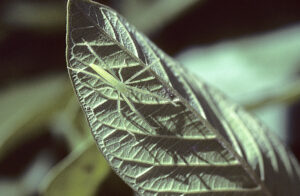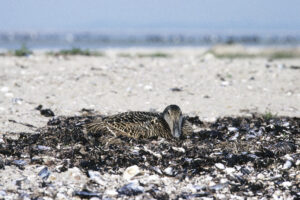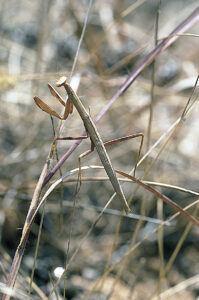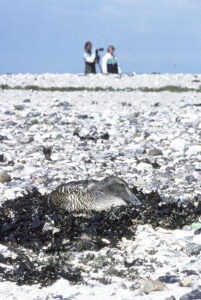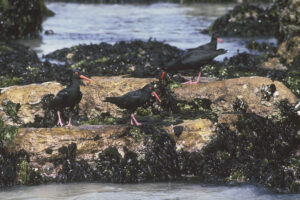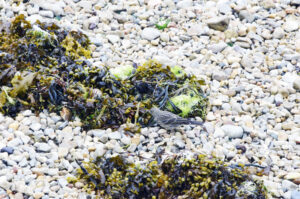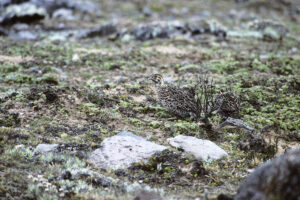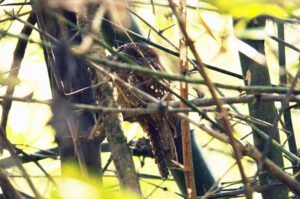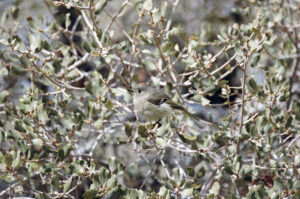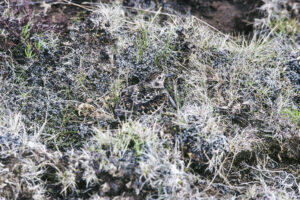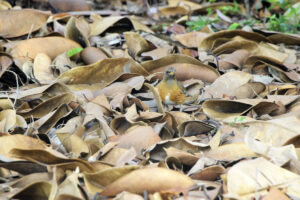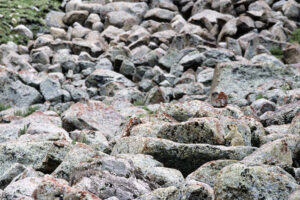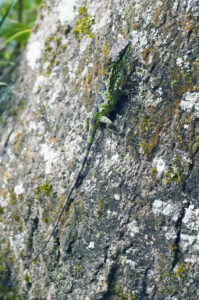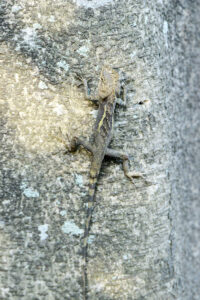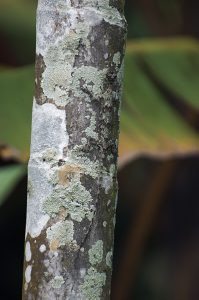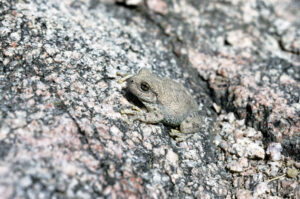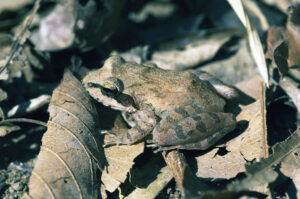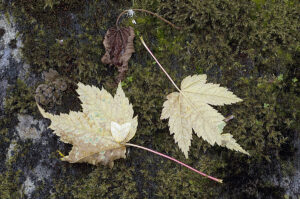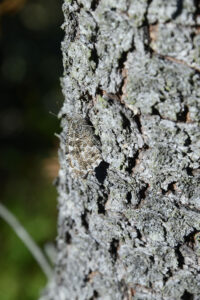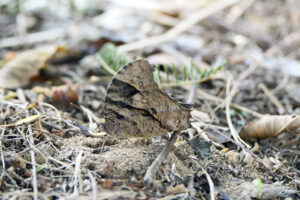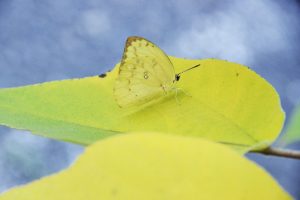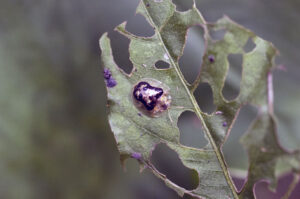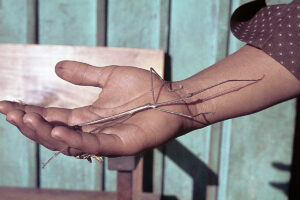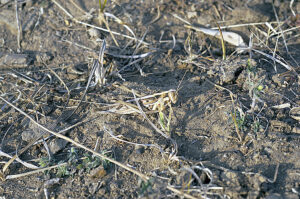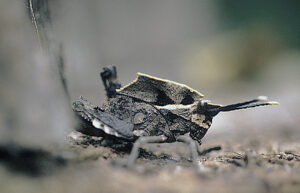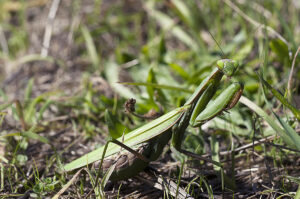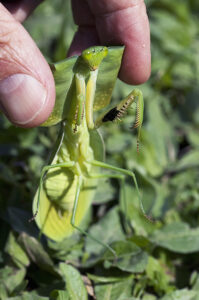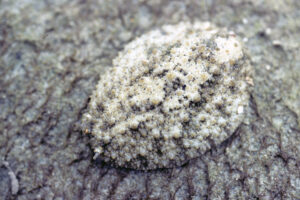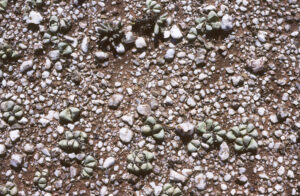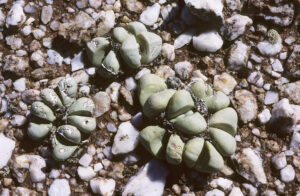Camouflage in nature
This thin, green spider, probably a species of Matidia, was observed near Banawe, northern Luzon, Philippines. Its long legs resemble the nerves on the underside of the leaf, on which it is sitting. (Photo copyright © by Kaj Halberg)
The mottled plumage of this incubating female eider (Somateria mollissima), photographed on the Mågeøerne Islets, Funen, Denmark, blends in very well with the washed-up seaweeds, in which she has placed her nest. The species is described below. (Photo copyright © by Kaj Halberg)
This tiny crab blends in very well with the grey sand on a beach, Bali, Indonesia. (Photo copyright © by Kaj Halberg)
Praying mantises are often remarkably well camouflaged, resembling a withered grass stem, like this one in Helambu, Nepal. (Photo copyright © by Kaj Halberg)
Birds
Anatidae Ducks, geese, and swans
At present, this large worldwide family contains 43 genera with about 146 species.
Somateria Eiders
A small genus of large ducks with 3 species, found in arctic, subarctic, and temperate areas of the Northern Hemisphere.
The generic name is derived from Ancient Greek soma (‘body’) and erion (‘wool’), referring to soft down feathers of these birds. The name eider is derived from the Icelandic name of the common eider, æðarfugl, which stems from Old Norse æðr.
Somateria mollissima Common eider
The common eider has an almost circumpolar distribution, found along Arctic and northern temperate coasts, from the Kola Peninsula westwards across Scandinavia, the northern British Isles, Iceland, Greenland, Maine, Arctic Canada, and Alaska, to the extreme eastern Siberia.
The nest of this species is built near the seashore, lined with down, which the female plucks from her own breast. This soft down has been harvested by people for hundreds of years, used as filling in pillows, quilts, and jackets. This harvesting was done with no harm to the birds, as it took place when the ducklings had left the nest.
The specific name is derived from the Latin mollissimus (‘very soft indeed’), like the generic name alluding to its soft down feathers.
In Northumberland, southern Scotland, the eider duck is known as the cuddy duck, named after Saint Cuthbert (c. 634-687), a monk, bishop, and hermit of the early Northumbrian Celtic church. While on the Farne Islands, he instigated special laws to protect the ducks and other seabirds, nesting on these islands.
The mottled plumage of this incubating female eider, photographed on the Mågeøerne Islets, Funen, Denmark, blends in very well with the washed-up seaweeds, in which she has placed her nest. (Photo copyright © by Kaj Halberg)
Charadriidae Plovers and lapwings
This family of small to medium-sized waders comprise about 10 genera with about 65 species. They are distributed almost worldwide, the vast majority near wetlands.
Pluvialis Golden plovers
This genus contains 4 species, 3 golden plovers and the grey plover (P. squatarola). Formerly, it was believed that there was only a single species of golden plover, P. apricaria, which was divided into 3 subspecies. However, these subspecies have since been upgraded to separate species, the Eurasian golden plover (P. apricaria, below), the Pacific golden plover (P. fulva), which breeds from central Siberia eastwards to western Alaska, and the American golden plover (P. dominica), found in the northernmost regions of North America.
The generic name is derived from the Latin pluvia (‘rain’). Formerly, it was believed that when golden plovers would flock, it was a sign of imminent rain. In Icelandic folklore, the arrival of the first golden plover means that spring has come.
Pluvialis apricaria Eurasian golden plover
This bird breeds in Arctic and northern temperate areas, from Iceland and Scotland in the west across northern Europe to central Siberia.
The specific name is derived from the Latin apricus (‘sunny’), thus loosely translated as ‘basking in the sun’.
This nest of a Eurasian golden plover at Þingvellir, Iceland, is very well camouflaged, as the pattern on the eggs resemble the straw and lichens, surrounding the nest. (Photo copyright © by Kaj Halberg)
Haematopodidae Oystercatchers
This family contains 11 extant species, all belonging to the genus Haematopus. Most of these birds live on coasts around the world, except the polar regions and some tropical regions of Africa and Southeast Asia. Three species, the Eurasian (H. ostralegus), the South Island (H. finschi), and the Magellanic (H. leucopodus), also breed inland. The Canary Islands oystercatcher, variously regarded as a subspecies of the Eurasian oystercatcher or as a separate species, H. meadewaldoi, became extinct around 1940.
The generic name is derived from Ancient Greek haima (‘blood’) and pous (‘foot’), alluding to the bright red feet of the Eurasian oystercatcher. The old English name of these birds was sea-pie (‘the pied one living at the sea’). They got their present name in 1731 by English naturalist Mark Catesby (1683-1749) who studied flora and fauna in the New World. He noticed that the American species H. palliatus ate oysters.
Haematopus moquini African oystercatcher
This species is restricted to coasts along Namibia, South Africa, and southern Mozambique.
The specific name was given in honour of French naturalist Alfred Moquin-Tandon (1804-1863) who was initially professor of zoology in Marseille, later professor of botany and director of the botanical gardens at Toulouse, and from 1853 director of the botanical garden and the scientific academy in Paris.
These African oystercatchers blend very well with dark seaweeds, growing on rocks, Muizenberg, near Cape Town, South Africa. (Photo copyright © by Kaj Halberg)
Laridae Gulls, terns and skimmers
This large cosmopolitan family contains 22 genera with about 100 species.
Sternula Terns
A genus with 7 species of small terns, widely distributed in temperate and subtropical waters of the planet.
The generic name is a diminutive of the genus name Sterna (true terns), in which they were formerly included. The common name is derived from Old Norse therna, presumably brought to the British Isles by Vikings.
Sternula albifrons Little tern
The little tern has a very wide breeding distribution, with main strongholds in west-central Asia and the Far East, and with scattered populations in Europe, western Africa, Indonesia, the Philippines, and New Guinea. During the 20th Century, most European populations declined drastically due to habitat loss, pollution, and human disturbance.
The specific name is derived from the Latin albus (‘white’) and frons (‘forehead’).
I nearly stepped on these juvenile little terns, before I noticed them, flattening themselves among pebbles, Nissum Fjord, Jutland, Denmark. (Photo copyright © by Kaj Halberg)
Motacillidae Wagtails, pipits, and longclaws
This family contains 6 or 7 genera with altogether c. 65 species. Wagtails and pipits are found in most parts of the planet, whereas the colourful longclaws (Macronyx) are restricted to Tropical Africa.
Anthus Pipits
Most pipits have a rather drab plumage, mainly brown with darker streaking, an adaptation to their feeding among grass or on bare soil. These birds constitute a rather large genus, comprising 34-46 species, depending on authority. They are distributed in most parts of the globe, except Antarctica.
Greek scientist and philosopher Aristotle (384-322 B.C.) mentions anthos, a small, brightly coloured bird, and Roman naturalist Pliny the Elder (23-79 A.D.) mentions anthus, both maybe referring to the yellow wagtail (Motacilla flava).
In Greek mythology, Anthos, son of Antinous and Hippodamia, was trampled to pieces by his father’s horses. The gods transformed him into a bird, which would imitate the neighing of a horse, but always fled from the sight of horses. Perhaps Aristotle had noticed wagtails taking off because of horses.
Anthus petrosus Rock pipit
This bird breeds along rocky and stony coasts in northern and western Europe, from northern Norway and the Kola Peninsula southwards through Scandinavia and the Baltic Sea to the British Isles and north-western France.
The specific name is derived from the Latin petra (‘rock’ or ‘stone’) and the suffix osus, thus ‘living among rocks’.
This rock pipit is well camouflaged, feeding among washed-up seaweeds, Camaret-sur-Mer, Brittany. (Photo copyright © by Kaj Halberg)
Phasianidae Pheasants and allies
This family, containing about 190 species, includes pheasants, partridges, junglefowl, Old World quails, peafowl, grouse, and many others. These birds are found worldwide, except in Antarctica.
Francolins and spurfowl
Until the early 1990s, most authorities placed all francolins, comprising about 40 species, in the genus Francolinus. Following genetic studies, they have since been split into several genera, and the systematics have been revised several times.
Three Asian species have been retained in Francolinus, whereas the remaining two Asian species have been moved to the genus Ortygornis, together with the African crested francolin (O. sephaena).
The remaining African species have been divided into several genera, Scleroptila (7 species), Campocolinus (3 species), Peliperdix (1 species), and Pternistis (24 species). All members of the latter genus are now referred to as spurfowl.
Finally, genetic research has shown that Nahan’s francolin is not a francolin, but closely related to the stone partridge (Ptilopachus petrosus), and for this reason it has been renamed Nahan’s partridge (Ptilopachus nahani).
Scleroptila
This genus contains 9 species, widely distributed south of the Sahara.
The generic name is derived from Ancient Greek skleros (‘stiff’) and ptilon (‘feather’).
Scleroptila psilolaema Moorland francolin
This species is endemic to Ethiopia, where it lives in highland moorland. Its speckled plumage is a perfect adaptation to its habitat.
The specific name is derived from Ancient Greek psilos (‘naked’) and laimos (‘throat’).
Moorland francolins, Sanetti Plateau, Bale Mountains National Park, Ethiopia. (Photo copyright © by Kaj Halberg)
Podargidae Frogmouths
A family with 16 species of nocturnal birds with a large, flattened, hooked bill and a huge frog-like gape, an adaptation to catch large nocturnal insects. They are distributed in the Indomalayan and Australasian regions.
Batrachostomus
This genus contains 12 species, found in Tropical Asia, from the Indian Subcontinent eastwards across Indochina to the Philippines, and thence southwards to Indonesia.
The generic name is derived from Ancient Greek batrakhos (‘frog’) and stoma (‘mouth’).
Batrachostomus moniliger Sri Lanka frogmouth
This bird, to 23 cm long, is found in dense forests of the Western Ghats of south-western India, and Sri Lanka.
The specific name is derived from the Latin monile (‘necklace’ or ‘collar’), and gerere (‘to carry’).
Male and female Sri Lanka frogmouth, sitting close together in a dense growth of bamboo, Mahaveer Wildlife Sanctuary, Goa, India. (Photo copyright © by Kaj Halberg)
Regulidae Goldcrests and kinglets
This small family contains 6 species, of which 5 belong to the genus Regulus, one to the genus Corthylio (below). They are found in Eurasia and North America.
Corthylio calendula Ruby-crowned kinglet
One of the smallest songbirds in North America. This species was formerly placed in the genus Regulus, but genetic research has shown that it is not closely related to other kinglets, and has therefore been moved to a separate genus.
It breeds in coniferous forests of Alaska and Canada and in montane areas of north-western United States, spending the winter in south-western Canada, the United States, and Mexico.
The generic name is derived from Ancient Greek korthilos, a small, wren-like bird mentioned by Greek grammarian Hesychius of Alexandria (5th or 6th Century A.D.). The specific name may be derived from the verb caleo (‘I am warm’, or ‘glowing’), alluding to the fiery colour on the head.
This ruby-crowned kinglet is very well camouflaged in a bush, Joshua Tree National Park, California. (Photo copyright © by Kaj Halberg)
Scolopacidae Sandpipers and allies
This large family, comprising about 15 genera and c. 95 species, is found across the globe, except in Antarctica.
Calidris Sandpipers
A genus of 24 species of smallish to very small waders, most of which breed in the High Arctic, spending the winter on shores around the world.
The generic name is derived from Ancient Greek kalidris, a term used by Greek philosopher Aristotle (384-322 B.C.) for some grey-coloured water bird.
Calidris maritima Purple sandpiper
This bird breeds in Arctic mountains in northern Canada, from Banks Island southwards to Ellesmere and Baffin Islands, in Greenland, Iceland, Jan Mayen, Bear Island, Svalbard, along the Scandinavian mountain range, northern Norway, extreme north-western Russia, Franz Josef Land, Novaya and Severnaya Zemlya, and on the Taimyr Peninsula.
It spends the winter months along shores of north-western and western Europe, southwards to Portugal, in extreme southern Greenland, and along the North American Atlantic Coast, southwards to South Carolina.
The specific name is Latin, meaning ‘living at the sea’, derived from mare (‘sea’). In winter, the bird is usually observed along coasts.
From a distance, this incubating purple sandpiper is almost impossible to spot among the withered grass on Selvogsheiði Moor, southern Iceland. I only found this nest, because I observed the bird from my car, when it was relieving its incubating mate. (Photo copyright © by Kaj Halberg)
Turdidae Thrushes
Thrushes constitute a large, almost global family of small to medium-sized birds, which spend much time feeding on the ground for worms and other invertebrates, and many species also eat fruit. Previously, this family was much larger, including many genera which are today included in the Old World flycatcher family (Muscicapidae).
The word thrush is derived from Old English throstle, from Proto-Germanic þrustlō, an ancient name for the song thrush (Turdus philomelos). In Old Saxon, þrustlō became throsla, in German Drossel. The latter name was adopted by the Danes, whereas the Swedes use the name trast for these birds, and the Norwegians trost.
A number of thrush species are dealt with on the page Animals – Birds: Thrushes.
Turdus Typical thushes
This genus, comprising 84 species, has an almost cosmopolitan distribution. Most of the northern species are migratory.
The generic name is the classical Latin word for thrush.
Turdus chrysolaus Brown-headed thrush
This bird is endemic to East Asia, breeding from Sakhalin and the Kuril Islands southwards to central Honshu, Japan, spending the winter in southern Japan, Taiwan, and the Philippines. It is mainly of a warm brown colour, with reddish breast and white central belly. The male has blackish-brown head and throat, whereas the female has whitish throat with black vertical stripes.
The specific name is derived from Ancient Greek khrysos (‘gold’) and laios (‘thrush’).
This female brown-headed thrush is very well camouflaged, feeding among dead leaves, Tunghai University Park, Taichung, Taiwan. (Photo copyright © by Kaj Halberg)
Mammals
Sciuridae Squirrels
A huge family with about 51 genera and c. 300 species, distributed in the major part of the Americas, Eurasia, and Africa. They have also been introduced by humans to Australia.
The family name is derived from Sciurus, the Latin name of these animals, in 1758 applied by Swedish naturalist Carl Linnaeus (1707-1778) to the Eurasian red squirrel (Sciurus vulgaris). The word squirrel, which has been in use as early as 1327, is from the Anglo-Norman name esquirel, which is again from the Old French escurel, a corruption of the Latin sciurus, which is derived from Ancient Greek skia (‘shadow’) and oura (‘tail’), thus ‘shadow-tailed’, alluding to the habit of some squirrels to raise their bushy tails over the body, thus creating shade.
Many species of squirrel are presented on the page Animals – Mammals: Squirrels.
Marmota Marmots
Marmots are large, ground-living squirrels, comprising 15 species, which occur in Europe, Asia, and North America. They are the largest and fattest of squirrels, growing up to 60 cm long and weighing up to 7 kg.
Marmots live in burrows up to 2 m underground, digging tunnels up to 10 m long. They often sit on their haunches outside their burrow, and their shrill warning whistles can be heard far away. Marmots are almost exclusively vegetarians. They do not make food deposits, but in autumn they have become extremely fat, and hibernate throughout the winter.
Arctic hunters kill many hoary marmots (M. caligata) and Alaskan marmots (M. broweri), eating their delicious meat and using their soft underfur to make parkas.
The generic name is a corruption of the Latin muris montanus (‘mountain mouse’).
Marmota himalayana Himalayan marmot
This species lives in grassy areas above the tree line, at altitudes between 3,000 and 5,500 m. It is found from northern Pakistan eastwards along the northern outskirts of the Himalaya to the Sichuan and Yunnan Provinces, northwards across the Tibetan Plateau to Xinjiang, Qinghai, and Gansu.
A Himalayan marmot surveys its domain among lichen-covered boulders, blending very well with its surroundings, Nimaling, Upper Markha Valley, Ladakh. (Photos copyright © by Kaj Halberg)
Reptiles
Agamidae Agamas
Agamas are a large group of lizards, comprising 6 subfamilies with about 64 genera and more than 300 species, distributed in Asia, Australia, Africa, and southern Europe.
Diploderma Japalure
Most of these lizards, comprising about 47 species, are endemic to China, with some species found in Myanmar, Vietnam, Taiwan, and Japan. They were previously placed in the genus Japalura.
The generic name is Latin, meaning ‘double layer of inner skin’.
Diploderma brevipes Short-legged japalure
The total length of this lizard is about 25 cm, of which the tail is 15 cm. It is endemic to Taiwan, where it lives in montane forests, at elevations between about 1,000 and 2,200 m. It was formerly named Japalura brevipes.
The specific name is Latin, meaning ‘short-legged’.
This short-legged japalure blends well with a lichen-covered tree trunk, Malabang National Forest, Hsinshu, Taiwan. (Photo copyright © by Kaj Halberg)
Diploderma swinhonis Swinhoe’s japalure
This species, previously known as Japalura swinhonis, is also native to Taiwan. It feeds on arthropods and other small animals, living in forests, shrubberies, and city parks. It is often perched on trees where sunlight is present.
It was named in honour of British biologist Robert Swinhoe (1836-1877) who, in 1860, became the first European consular representative to Taiwan. He discovered many new species, and four mammals and 15 birds are also named after him.
This Swinhoe’s japalure is well camouflaged on a tree trunk, Taichung, Taiwan. (Photo copyright © by Kaj Halberg)
Draco Gliding lizards
This genus of unique agamids contains about 40 species, all but one restricted to Indochina, Malaysia, the Philippines, and Indonesia. A single species, the Malabar gliding lizard (D. dussumieri), is found in south-western India.
Another name of these lizards is flying lizards, which is not a very descriptive name, as they are not able to truly fly, but glide from one tree to another by spreading out their ribs, which are connected by a wing-like membrane, called patagia.
The generic name is a Latinized version of Ancient Greek drakon (‘dragon’).
Draco volans Javan gliding lizard
Formerly, it was believed that this species had a wide distribution in Indochina, Malaysia, Indonesia, and the Philippines, but today it is considered to be restricted to Java and Bali.
The specific name is Latin, meaning ‘flying’.
This Javan gliding lizard is almost invisible, sitting on the lichen-covered trunk of a betel palm (Areca catechu), Bali, Indonesia. – This palm is described on the page Nature: Nature’s patterns. (Photo copyright © by Kaj Halberg)
Amphibians
Hylidae Tree frogs and allies
A large family with about 58 genera, distributed on all continents, except Antarctica, but in Africa restricted to the Mediterranean area.
Dryophytes
This genus contains about 20 species, most of which live in the New World, with 4 species in temperate areas of eastern Asia. These frogs are very similar to members of the Old World genus Hyla, and the validity of Dryophytes is doubtful.
The generic name is derived from Ancient Greek drys (‘oak tree’) and phyton (‘plant’) – a rather strange double name, alluding to most species living in trees.
Dryophytes arenicolor Canyon tree frog
As its common name implies, this frog, previously known as Hyla arenicolor, lives in rocky areas. It is distributed in the south-western United States, from Colorado, Utah, Arizona, New Mexico, and Texas southwards to the Mexican states Michoacán, México, Guanajuato, Guerrero, and Oaxaca.
The upperside is brown or grey with darker spots, an adaptation to help it being camouflaged among the brownish or greyish rocks, where it lives. The underside is cream-coloured or orange-yellow.
The specific name is Latin, meaning ‘sand-coloured’.
This canyon tree frog blends in well with the colours of this rock, Grand Canyon, Arizona. (Photo copyright © by Kaj Halberg)
Rhacophoridae
Members of this family, comprising about 24 genera, are popularly known as shrub frogs or bush frogs. They live in Africa south of the Sahara, and from the Indian Subcontinent eastwards to Japan, and thence southwards to Indonesia.
Pseudophilautus
These bush frogs, comprising about 80 species, are restricted to Sri Lanka and the Western Ghats of southern India. Many species are highly endangered, mainly due to habitat destruction, and about 13 species have already become extinct.
Pseudophilautus amboli Amboli bush frog
This rare frog is endemic to the Western Ghats, found from southern Maharashtra southwards to Karnataka. It is small, the largest specimens measuring about 3.7 cm. It lives in forests and is critically endangered due to habitat destruction and fragmentation.
This Amboli bush frog is well camouflaged among withered leaves on the forest floor, Mahaveer Wildlife Sanctuary, Goa. (Photo copyright © by Kaj Halberg)
Crabs
Matutidae Moon crabs
All 5 pairs of legs of these crabs are flattened, an adaptation for swimming or digging.
This moon crab is completely covered in a growth of sea algae, making it almost invisible, Mindoro, Philippines. (Photo copyright © by Kaj Halberg)
Scorpions
Scorpions are predatory animals, characterized by a pair of so-called pedipalps, with which they grab their prey, and their tail, often carried in a curve over the back, ending in a venomous stinger.
These animals vary enormously in size, from Typhlochactas mitchelli, which is only 9 mm long, to Heterometrus swammerdami, which can reach a length of 23 cm.
Yellow scorpion in yellow sand. – I found it one morning, hidden under my bedding, during a camel safari into the Thar Desert, Rajasthan, India. My adventures in this desert are related on the page Travel episodes – India 2003: Camel safari in the Thar Desert. (Photo copyright © by Kaj Halberg)
Insects
Butterflies and moths, and their caterpillars, are often well camouflaged.
This moth is almost invisible, sitting on a fallen leaf of a tail-leaved maple (Acer caudatum), Tharepati, Helambu, Nepal. (Photo copyright © by Kaj Halberg)
Sitting on a yellow leaf, this hairy caterpillar is very well camouflaged. Note the black spot on its body, resembling a hole in the leaf. – Malabang National Forest, Hsinchu, Taiwan. (Photo copyright © by Kaj Halberg)
An almost invisible moth, sitting on bark next to a cocoon, Chingshuian Recreation Area, Taiwan. (Photo copyright © by Kaj Halberg)
Nymphalidae Brush-footed butterflies
Comprising more than 6,000 species, this is the largest butterfly family, distributed on all continents, except Antarctica. Today, this family includes a number of subfamilies, which were previously treated as separate families, including Heliconiinae, Danainae, and Satyrinae.
The name brush-footed butterflies refers to a brush-like set of hairs on the forelegs of a number of species. Another common name is four-footed butterflies, as many members are known to stand on only four legs. The forelegs are reduced and often curled up.
Hipparchia
This genus, containing about 40 species, is widespread in Eurasia, northern Africa, the Canary Islands, and the Azores.
The genus is named after the Greek philosopher Hipparchia of Maroneia, who lived in Athens around 325-350 B.C. She was married to another philosopher, Crates of Thebes, and the couple lived a life of poverty in the streets of Athens.
Hipparchia semele Grayling
This species is found all over Europe, predominantly in coastal areas, inland populations sometimes reaching elevations up to about 2,000 m. Its cryptic colours on the underwing, mainly grey and brown, make them very hard to spot, when they sit on lichen-covered tree trunks, or in sandy areas. In case it feels threatened, it will suddenly flash the eyespot on the forewing to confuse the predator.
In Greek mythology, Semele was a daughter of King Cadmus of Thebes. She was abducted by Zeus and gave birth to a son, Dionysus, who later became the wine god.
Grayling, sitting on the trunk of a lodgepole pine (Pinus contorta), Thy, Denmark. In the lower picture, it shows the ‘eye’ on the forewing. (Photos copyright © by Kaj Halberg)
Junonia Pansy, buckeye, commodore
This genus, comprising about 33 species, is found on all continents except Antarctica. It was established in 1819 by German entomologist Jacob Hübner (1761-1826), who was one of the first to study butterflies in depth. He described many new genera and species and was the author of Sammlung Europäischer Schmetterlinge (‘Collection of European Butterflies’), published 1796-1805.
In Roman mythology, the goddess Juno was the protector and special counsellor of the state. She was the daughter of Saturn, the wife of Jupiter, and the mother of Mars, Vulcan, Bellona, and Juventas. Her Ancient Greek counterpart is Hera.
Previously, many of the species were placed in the genus Precis.
Junonia almana Peacock pansy
A very common species, living in a wide variety of habitats up to altitudes around 1,000 m. It is distributed from India and Sri Lanka eastwards to southern China, Indochina, the Philippines, and Indonesia.
The underside of this peacock pansy blends very well with the soil it is sitting on, Taichung, Taiwan. (Photo copyright © by Kaj Halberg)
Pieridae Whites, sulphurs, orange-tips
This large family, comprising about 76 genera and 1,100 species, is distributed almost worldwide, with the highest concentration in tropical areas of Africa and Asia. The pigments that give the characteristic colour of these butterflies are derived from waste products in their body.
Catopsilia Migrants, emigrants
A small genus, comprising about 6 species, found in Africa, Madagascar, Tropical Asia, and Australasia. The popular names refer to several species being strongly migratory.
Catopsilia pomona Lemon emigrant
A widely distributed butterfly, found from the eastern Himalaya eastwards to eastern China, Taiwan, and Japan, and thence southwards through Indochina, Malaysia, Indonesia, and the Philippines to Australia and islands in the Pacific.
The specific name refers to Pomona, Roman goddess of fruit abundance. Like the common name it alludes to the lemon-like colour of this species.
This lemon emigrant is well camouflaged on a winter leaf of paper mulberry (Broussonetia papyrifera), Taichung, Taiwan. This tree is presented on the page Nature: Invasive species. (Photo copyright © by Kaj Halberg)
Chrysomelidae Leaf beetles
A very large family, probably containing over 40,000 species, divided into more than 2,500 genera. Members are found on all continents, except Antarctica.
Turtle beetles, subfamily Cassidinae, are a large group of more than 3,000 leaf beetles, which resemble miniature turtles due to the forward and sideways extensions of their body. They measure between 5 and 12 mm in length, and the larvae are spiny. Both adults and larvae eat leaves, and some species are regarded as agricultural pests.
One genus in the subfamily is Cassida, containing more than 430 species, distributed in the Old World. The generic name is derived from the Latin cassis (‘metal helmet’).
Cassida sauteri Shaude’s turtle beetle
This species, growing to about 7.5 mm long, is distributed in southern China, Taiwan, and the Japanese Ryukyu Islands.
This Shaude’s turtle beetle resembles a bird dropping. It has eaten large parts of a leaf of an Achyranthes species, observed in Malabang National Forest, Taiwan. (Photo copyright © by Kaj Halberg)
Phasmatodea Stick insects
As their name implies, these insects, also called walking sticks, resemble sticks, or withered grass stems, making them difficult for predators to spot. They are found on all continents, except Antarctica, with the highest diversity in the Tropics.
Stick insects can grow fairly large, as this one in Sumatra, Indonesia. The largest species, found in Borneo, has a body length up to 35 cm. (Photo copyright © by Kaj Halberg)
This stick insect was encountered in Rondo Forest, southern Tanzania. (Photo copyright © by Kaj Halberg)
Orthoptera Grasshoppers and allies
This order is divided into to suborders, Caelifera (grasshoppers) and Ensifera (crickets, katydids, and others). Both groups are characterized by mouthparts adapted for biting and chewing, hind legs modified for jumping, and organs to produce their characteristic sounds. Ensiferans have much longer, threadlike antennae than the grasshoppers, often longer than their bodies.
These animals are plant-eaters, and some species at times become serious pests, forming huge swarms that consume crops over wide areas. Most species protect themselves from predators by camouflage. If detected, they suddenly jump into the air, many species displaying brilliantly coloured wings to startle the predator. Other species have strong colours as a warning to predators that they are ill-tasting.
This grasshopper, observed in Bagan, Myanmar, resembles the withered grass around it. Note the red mites on its body. (Photo copyright © by Kaj Halberg)
This grasshopper, encountered in the Rondo Forest, southern Tanzania, greatly resembles a withered leaf. (Photo copyright © by Kaj Halberg)
Mantodea Praying mantises
This order contains about 30 families with c. 430 genera and more than 2,400 species. These animals are distributed worldwide in warmer temperate, subtropical, and tropical regions, living in a variety of habitats.
They are carnivorous insects that will wait in ambush in the vegetation for an insect or another small invertebrate to pass by. With lightening speed, the mantis throws its forelegs forward and snatches the unfortunate victim, which is then devoured by the mantis. Sometimes a female will even eat the male, after he has inserted his semen in her.
These insects got their name from their posture, with the forelegs ‘folded’, as if they were in prayer – quite contradictory to the real purpose of this posture. Preying mantis would be a more proper name!
This Californian praying mantis (Stagmomantis californica), encountered in Sinkyone Wilderness State Park, California, sits motionless in the vegetation, waiting for prey to pass by. (Photo copyright © by Kaj Halberg)
Some praying mantises resemble leaves, like this one, of the genus Choeradodis, encountered in Cordillera de Tilarán, Costa Rica. (Photos copyright © by Kaj Halberg)
Molluscs
This extremely well camouflaged sea slug is rasping off algae from the surface of a rock, Pulau Kapas Island, Malaysia. (Photo copyright © by Kaj Halberg)
Plants
Aizoaceae Ice plant family, midday flower family
This large family contains about 135 genera and 1,800 species of succulents, almost all endemic to arid areas in southern Africa. A few species are found in the Mediterranean area, Australia, New Zealand, some Pacific islands, and North America.
The family name is derived from Ancient Greek aeizoon (‘houseleek’), from aei (‘forever’) and zoion (‘a living thing’), alluding to the succulent, long-living leaves of the members, similar to the houseleeks (Sempervivum).
Lithops
Plants of this genus, comprising about 37 species, remarkably resemble the pebbles, among which they grow. They are confined to South Africa, Namibia, and Botswana.
The generic name is derived from Ancient Greek lithos (‘stone’) and ops (‘resembling’), referring to the similarity of these plants to small stones. Popular names include living stones and pebble plants.
This species of Lithops was photographed on Knersvlakte (‘Grinding Plain’), near Vanrhynsdorp, South Africa. (Photos copyright © by Kaj Halberg)
(Uploaded February 2018)
(Latest update October 2024)
